I’ve never liked shows like Lifestyles of the Rich and Famous. I’m uninterested in what Paris Hilton spent on a dog palace, am only slightly amused by what Sony Bono paid to fly his hat. I’ve never understood the point. Am I to envy? To condemn? I’m as prone to consumerism as the next American, but it’s easy to watch The Queen of Versailles and think, I would never expect a rental car company to supply a driver. What entitlement! Now where is that amazing silver necklace on Etsy…
I know my part in America’s deploring—and dangerous—overconsumption is something I should ponder, but these stories so rarely implicate average Americans, or say anything interesting about the culture most of us rarely question.
That’s why I like Easy Living (1937), an airy comedy about a girl just scraping by who—due to a series of misadventures—is mistaken for a banker’s mistress, and flooded with offers of well, everything, in return for just a tip or two about whether steel is up or down this week. What this fictional movie supplies that other shows and documentaries lack is a perspective on capitalism run stupid I rarely see, but have experienced: befuddlement.
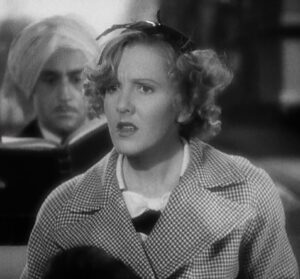
Our heroine, Mary Smith (Jean Arthur), enters the film on a streetcar. A sable coat suddenly lands on her head. Does she try to discover its origins? Does she ponder the nature of serendipity, or “kismet,” as her religious fellow passenger does? No. It ruined her hat, she can’t afford to replace it, and now she has to be late for work to help the idiot who threw it.
She approaches the banker (Edward Arnold) responsible for the coat’s airborne condition.

Moved by her innocence, he gives it to her, and a new hat besides. She takes the gifts as payback and benevolence, rather than as signs of sexual interest. Unfortunately, her stuffy employer doesn’t share this interpretation. He fires her for immorality.
Soon afterward, she befriends John Ball, Jr., the banker’s son (Ray Milland), after he steals a meal for her. Accompanied by her new knight-in-disguise, she starts getting offers from those who, like her employer, consider her a strumpet, but are glad she is. A hotel proprietor (Luis Alberni) offers her a room, hoping to extend his loan with her benefactor. She takes it, with no idea why it’s been offered. Her increasing confusion as questions and freebies fly her way is hilarious to witness.
The film is a pleasure for many reasons, Jean Arthur first among them. As a satire of consumerism, it’s incisive and often dark despite its frothiness, as these three scenes reveal:
1: The Coat
The banker, J.B. Ball (Arnold), begins the day disgruntled. He grumbles over his hearty breakfast, fights with his son (Ray Milland) over an expensive foreign car, then discovers this bill from his wife (Mary Nash):

He storms into her room, demanding why she needs such a luxury, especially with a closet like this:

She defends herself, claiming her other furs are out of fashion, that she doesn’t have so many, and then she runs away with the sable, impeding his race after her. The fight ends with some rooftop wrestling.

The rich banker, complaining of his family’s extravagance, tosses out a fortune like a tissue. (I wish I could claim the rest of us never show such hypocrisy, even if less flamboyantly/expensively expressed…)
2: The Automat
Mary doesn’t have enough money for a decent dinner, but enough appetite to envy those who do:
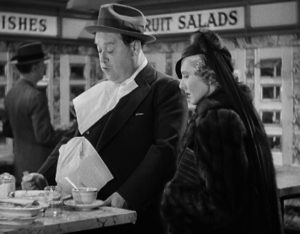
She’s at an automat, a kind of vending machine restaurant with windows of entries. When the banker’s son (Milland), who is working there, suggests in a misplaced effort at flirtation that she have the meat pie, she retorts, “If you can suggest where to get the nine nickels, I might take your suggestion; otherwise, don’t go around putting ideas in people’s mouths.”
When he offers to spring a door so that she can steal one, she at first resists. But as she attempts to eat her humble meal, she reconsiders.
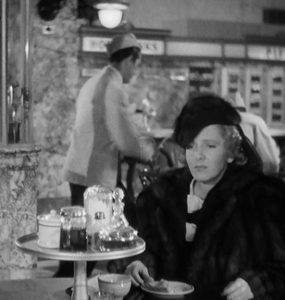
Of course, she breaks down, and of course, a security guard catches Junior, who promptly starts a fight that leads to a free-for-all at the automat the two barely escape.
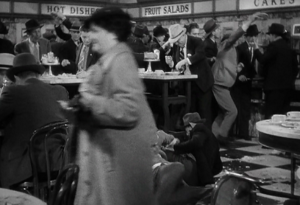
This simple portrayal of the hunger an underfed woman feels as everyone around her overconsumes was a bit too on point to be funny. It did give me a fun flashback of when a vending machine in college went haywire, and I made out. But it also reminded me of when I returned from a visit to Ghana, and was overcome by the excessive options in my grocery store.
The Room
Lifestyles of the Rich and Famous couldn’t possibly capture the luxuriousness of a hotel run by Mr. Louis Louis (Alberni). When he displays a suite for Mary, he can’t even remember its layout, though he does remember to attack the competition’s inferior claims. What other Imperial Suite could boast 5 reception areas, and this monstrosity for a bathtub?

Mary is not impressed by such affectations. She is–quite frankly–confused why anyone would want such nonsense.

Once alone, she’s even a bit frightened.

She doesn’t know what to do with any of it, until she remembers one feature in this new suite of hers, and finally feels what Mr. Louis Louis wanted her to feel. She tears across the room, running past all the silk and marble and chandeliers to one thing that she considers worthy of attention: the fridge.
As a satire of luxury, it’s hard to imagine any scene harsher than this one. Trust writer Vera Caspary (of Laura fame), who penned the story, and screenwriting genius Preston Sturges to lacerate us with their black humor. Even though the critique is cloaked in pratfalls and silliness, it’s still there for us to see. Maybe all these years later, the lesson will actually penetrate our own product-loving minds….at least until the holidays.
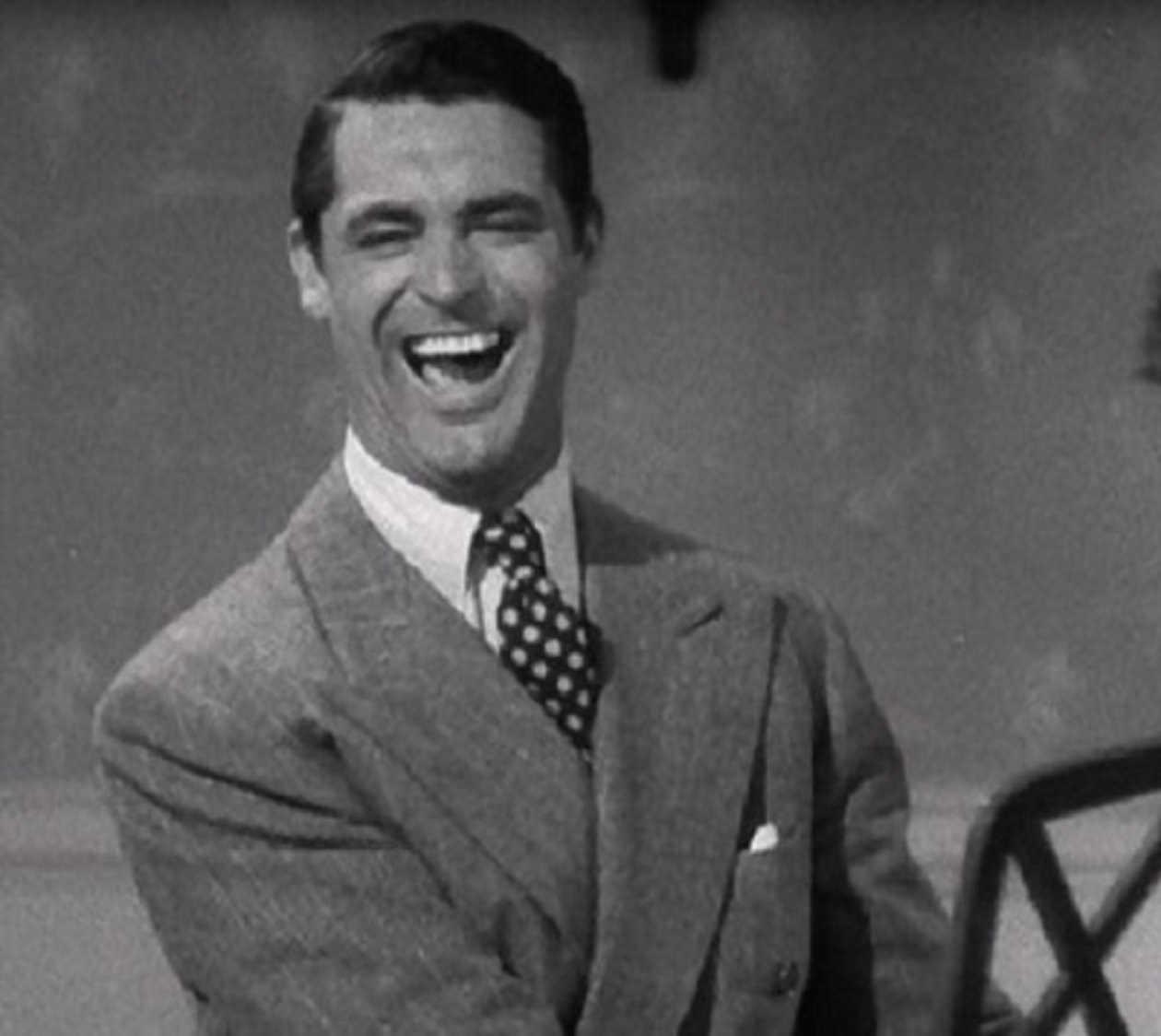


I LOVE this movie, and this is an insightful analysis. Last time I saw it, I was really struck by how prominently Mary’s (actual, non-metaphorical) hunger figured into the plot. As you point out, it’s really visceral in the shots of Arthur watching the other diners in the automat, and running to the fridge. At the same time, the movie is hilariously zany, and successfully romantic (even the relationship between Arnold and Nash actually turns out to be rather sweet). Not an easy combo to pull off.
Thank you! I’m really amazed at the tone too. As you say, not at all easy to pull off. I think the first time I saw it, I only noticed the zaniness. But multiple viewings reveal just how nuanced it is. I agree that both relationships are sweet in the end. I particularly enjoy the Mary-John job search:)
Oh, I love this one! 1930s movies always have such a great sense of the “haves” and “have nots”—and even when indulging in over-the-top luxury on screen, they always seem to maintain a rational perspective on the opulence. You’re right that a lot of today’s media has a way more muddled viewpoint on how we’re supposed to feel… Sturges was much more clear (and nuanced)!
It’s so true. So many more of the 30s films gave a more complex perspective than today. What I like so much about this movie is that I notice more and more of that nuance every time I see it.